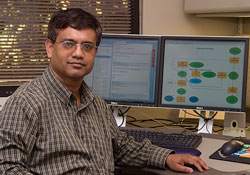ArcUser Online
Noman: That's kind of an interesting question. I started as a GIS user. I'm a water resources engineer, and I was using GIS to solve water resources problems like floodplain delineation and flood management. I liked the way I could use GIS so much that after doing my Ph.D. in water resources, I knew I wanted to work at Esri and ended up here. I've been working here for more than seven years, building GIS tools for GIS and water resources professionals. Q: Describe what you do here and what a typical day is like. Noman: Before we develop the software, we actually design it. Depending on where we are in the development cycle, we might spend more time initially in designing. But as we move forward, we start testing the functionality. As we find problems, we submit bugs, get them fixed, then test again. Eventually, we start to document it. Finally, once everything is done, we release the software. In between, we do other things such as answer users' questions and create applications like sample models and sample tools. As a product engineer, you get to do a lot of different things on a daily basis. Q: What do you find challenging about your job? Noman: The most interesting part about my job is that it's really dynamic—that's what keeps me here. No two days are the same. I come in and start my day, and sometimes it's totally different than what it was yesterday. Every day we face new challenges. We solve new problems, and it's changing every day. Q: What kinds of skills are needed for your team? Noman: We need and use different skills to develop our software's new functionality. Our developers come from different technical backgrounds but are very analytical by nature. Once you have those skills, we'll use your background or experience in many different ways. Q: What do you feel Esri offers its employees that sets it apart from similar organizations? Noman: Esri is a unique organization in many different ways. First, if you start with the technology, it is the software. Our software actually changes people's lives because it can be used to make better decisions, which eventually affects somebody else's life down the line. That is the technology part of it. If you think about the work environment, it is also unique because it is very friendly. Let me put it this way: we are very professional in an informal environment—we work like friends and colleagues with nice software. Q: What's the work environment like in your group? Noman: We work in teams, which means we develop software as a team. It's important that team spirit is high and cooperation is strong. Like any team in software development at Esri, our group also has great team spirit and we work closely together. It is a great environment. Q: What do you like about living in the Redlands area? Noman: Redlands is very close to Los Angeles, so you get all the benefits of a big town without living in a big town. For example, you can drive an hour and see the ocean, or you can go and see the mountains. Or, if you want to see Disneyland or Universal Studios, that's not far either. So, from Redlands, you can go in any direction and enjoy your life the way you want. That's a good thing about Redlands and living in this area. Q: Any closing thoughts? Noman: Esri is a great company. That's first and foremost. If you are a GIS professional and really want to change the way GIS is done and make it better, this is a great place for you. We welcome you here. If you work here, you'll enjoy it and you'll help us make things better. |
